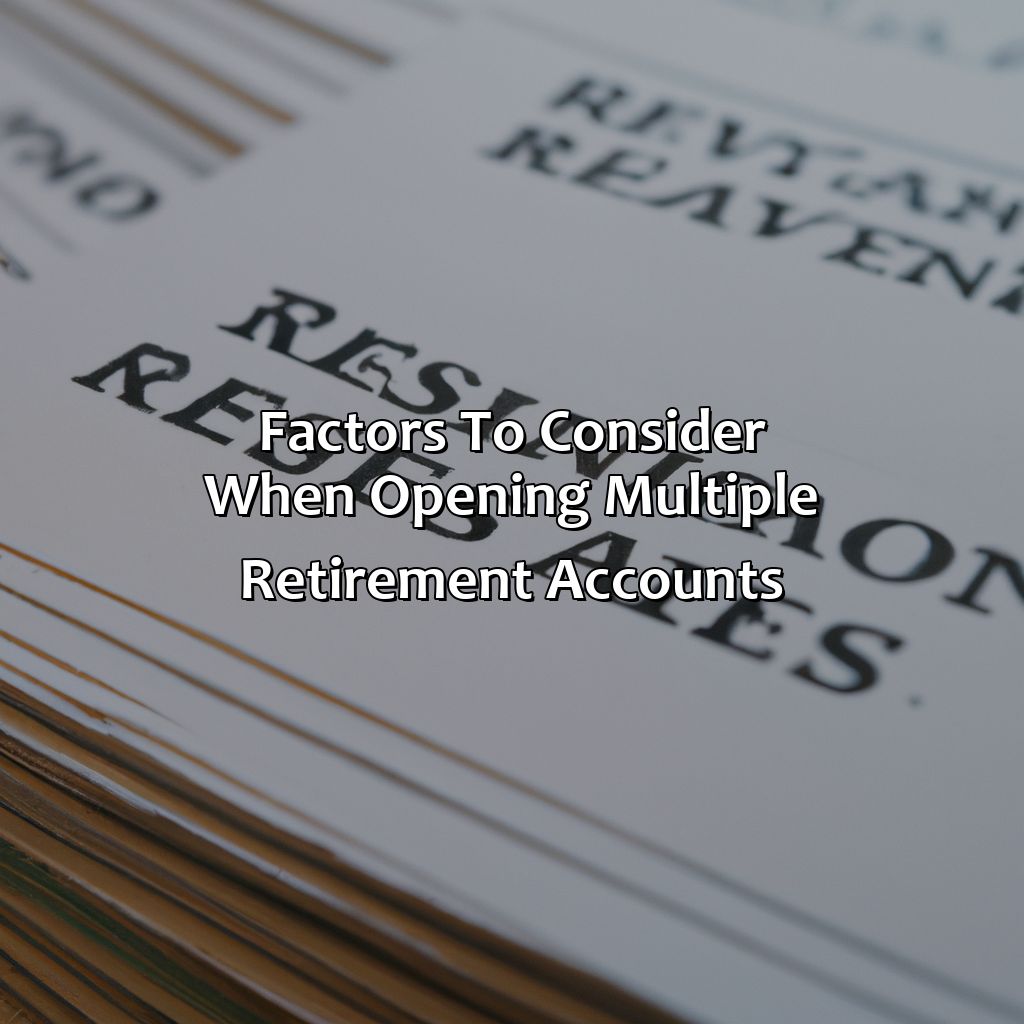How Many Retirement Accounts Can I Have?
Key Takeaway:
- You can have multiple retirement accounts: There’s no limit to the number of retirement accounts you can have. You can have a 401(k), an IRA, a Roth IRA, and more, as long as you comply with the contribution limits and other rules and regulations.
- Having multiple retirement accounts can provide diversification and tax advantages: By having different types of retirement accounts, you can spread your savings across different investment options and benefit from their tax advantages, which can help maximize your retirement income and minimize taxes in retirement.
- Consider your personal financial goals and investment options when deciding whether to open multiple retirement accounts: It’s important to evaluate your financial goals and investment options, and work with an advisor to create a retirement plan that’s suitable for your needs and circumstances.
Are you wondering how to best manage your retirement savings? With so many options available it can be difficult to know what is best for you. You can maximize your retirement savings goals by strategically using multiple retirement accounts. Let’s explore how many retirement accounts you can have.
How many retirement accounts can I have?
Want to know the answer to “How many retirement accounts can I have?“? Two things decide how much you save: the types of accounts available and the contribution limits. Manage your retirement funds efficiently by understanding these factors.

Image credits: retiregenz.com by Harry Woodhock
Types of retirement accounts
There are various Retirement Investment Account Options available to plan for a secure future. Below listed are some of the common types of retirement accounts with an overview of their purpose, rules and contribution limits.
| Type of Retirement Account | Purpose | Rules | Contribution Limits |
|---|---|---|---|
| 401(k) | Employer sponsored | Matched contributions allowed | $19,500 in 2020 |
| IRA (Individual Retirement Account) | Personal account | Tax-deductible contributions allowed | $6,000 in 2020 |
| Roth IRA | Personal account | Tax-free withdrawals at retirement | $6,000 in 2020 |
It is important to note that contribution limits differ based on several factors like age, income, and type of retirement account selected. Seek professional assistance before opening any new account.
The importance of choosing the right type of retirement account depends on your goals. Therefore selecting the right one will have a significant impact on the amount saved at retirement.
Did you know?The US Congress created tax-deferred Individual Retirement Accounts (IRAs) under Section 408(a) to encourage taxpayers to save more towards their post-retirement life.
Good news, you can have multiple retirement accounts! Bad news, you still have to follow the contribution limits. But hey, at least you can diversify your retirement portfolio and keep your financial advisor on their toes.
Contribution limits of retirement accounts
Retirement Accounts – Maximum Investment Limits
Maximizing one’s retirement savings is crucial for a stress-free post-retirement period. A person can have multiple retirement accounts, but how much they can contribute to each account depends on various factors such as age, income, and account type.
Below is a table that lists the maximum contribution limits for various retirement accounts:
| Account Type | Contribution Limit (2021) |
|---|---|
| 401(k) Plan | $19,500 |
| IRA (Traditional or Roth) | $6,000 (+$1,000 catch-up if over 50 years of age) |
| SIMPLE IRA | $13,500 (+$3,000 catch-up if over 50 years of age) |
| SEP IRA | Lesser of $58,000 or 25% of compensation |
It’s important to note that in some cases contribution limits are subject to change and may depend on specific individual circumstances. Tax consequences also vary depending on the account type and contributions made.
Remember to plan your contributions wisely to make the most out of your retirement savings.
Pro Tip: Do not wait until later in life to start saving for retirement. Start early and take advantage of compounding returns.
Why have one retirement account when you can have multiple options for your money to grow old and retire comfortably, just like you?
Benefits of having multiple retirement accounts
Optimize your retirement savings strategy with multiple accounts!
Check out the perks of diversifying savings and taxes. Spread investment risk with multiple accounts. Get flexibility in accessing funds and save on taxes. Maximize tax savings and reduce taxable income.

Image credits: retiregenz.com by James Arnold
Diversification of retirement savings
Optimizing your retirement savings with a diversified portfolio not only reduces the overall risk but also maximizes returns. Owning multiple retirement accounts is a great way to accomplish diversification of retirement savings, especially if each account invests in different asset classes or securities. By having multiple accounts, you can spread your risk across more than one platform, ensuring that one underperformance does not affect your entire portfolio.
Apart from diversifying, owning multiple retirement accounts allows you to take advantage of tax benefits offered by each account type and specific contribution limits. Owning a mixture of traditional IRAs, Roth IRAs, 401(k)s or similar employer-sponsored plans can help you navigate the ever-changing tax landscape while helping you save money on taxes.
The use of multiple retirement accounts is not a new concept; in fact, many individuals have successfully used this strategy to secure their financial future. For instance, billionaire investor Warren Buffet has been known to encourage people to invest in both stocks and bonds as a way of spreading risk for longevity in investing success. Similarly, diversification among different retirement accounts provides an avenue for growth and protection against adverse market shifts over time.
Saving money on taxes is like winning the retirement lottery, except you don’t have to wear ridiculous hats and pose for a photo op.
Tax efficiency
The efficacy of tax planning can be maximized by having multiple retirement accounts, such as Individual Retirement Accounts (as well as 401(k) plans). These accounts are diversified across taxable and tax-deferred contributions, which provides flexibility in managing taxes during retirement.
Having multiple retirement accounts allows investors to manage risks more effectively. For instance, a retiree who has both Roth and Traditional IRAs can plan withdrawal from the account that provides maximum tax benefits. Moreover, withdrawing money from different accounts lowers the overall tax liabilities since only a part of the funds is taxable.
Another aspect to consider is the implications for estate planning. Multiple retirement savings plans offer tremendous opportunities to pass on assets to beneficiaries and preserve wealth effectively.
Pro Tip: It is advisable to seek professional guidance to optimize your investments across various retirement accounts. A certified financial planner can help you navigate complex matters like taxes, investments, and other related aspects.
Because having too many retirement accounts can be like keeping a pen in every pocket – it’s convenient, but you’re just asking for confusion.
Factors to consider when opening multiple retirement accounts
Maximize your retirement savings potential? Consider opening multiple accounts! But, make sure you consider your financial goals first. Here, we’ll talk about factors to keep in mind when opening multiple retirement accounts. Focus on your personal financial goals and investment options.

Image credits: retiregenz.com by Yuval Washington
Personal financial goals
To optimize your retirement planning, it’s crucial to identify your financial objectives as they are the guiding principles for opening multiple retirement accounts. By setting up a diverse range of investment vehicles, you can maximize potential returns while minimizing risks.
A critical factor in achieving your retirement goals is to consider one’s age and how long they will keep the investments before withdrawal. It is pertinent to choose tax-advantaged plans that align with one’s strategy and offer varying benefits such as fixed income or high net return portfolio options.
It is essential to understand that each retirement account comes with its limitations on contribution limits, eligibility criteria, and fees structure. Therefore, it’s prudent to consult a financial advisor who can help balance between diversification approach and avoiding overlaps in other investment selections.
Choosing the right investment options for your retirement accounts is like picking a spouse – it’s a commitment, but if you choose wisely, it can lead to long-term happiness.
Investment options
When it comes to exploring multiple ways of investing in your future, there are various options to consider. Diversifying your investments through different accounts can help you achieve a comfortable life post-retirement.
Comprehend the various investment possibilities available in diverse retirement account types like 401(k)s, IRAs, and Roth IRAs, each with their unique tax implications and withdrawal rules. It’s essential to understand these investment options thoroughly before making any decisions.
Suppose you currently have only one retirement account and considering opening another account. In that case, always make sure that you maintain an adequate balance in all accounts and avoid paying excessive fees on one account over the others.
Don’t miss out on opportunities for maximizing your retirement savings by having multiple accounts. Explore different investment options available and take advantage of them while keeping your unique goals and financial situation in mind when opening multiple retirement accounts.
Five Facts About How Many Retirement Accounts You Can Have:
- ✅ There is no limit to the number of retirement accounts you can have, but there are contribution limits for each type of account. (Source: IRS)
- ✅ You can have multiple 401(k) accounts, but your total contributions cannot exceed the annual limit set by the IRS. (Source: Forbes)
- ✅ You can have both a traditional IRA and a Roth IRA, but your contributions to both accounts cannot exceed the annual limit set by the IRS. (Source: Investopedia)
- ✅ You can have a 401(k) and a self-employed retirement account, but your combined contributions cannot exceed the annual limit set by the IRS. (Source: NerdWallet)
- ✅ Having multiple retirement accounts can diversify your investments and help you achieve your retirement goals. (Source: Fidelity)
FAQs about How Many Retirement Accounts Can I Have?
How many retirement accounts can I have?
Individuals can have multiple retirement accounts, and the number is not limited by law.
What types of retirement accounts are available?
There are different types of retirement accounts available such as IRA, 401(k), Roth IRA, Solo 401(k), SEP IRA, and HSA.
Is there a limit on the amount I can contribute to my retirement accounts?
Yes, there are contribution limits set by the IRS for each type of retirement account. It is advised to consult with a financial advisor to understand the limits applicable to you.
Can I rollover my retirement accounts?
Yes, individuals can rollover their retirement accounts to another IRA or 401(k) plan without any tax implications. However, certain rules apply, and it is best to consult with a financial advisor before making any changes.
What are the benefits of having multiple retirement accounts?
Having multiple retirement accounts can provide diversification to your portfolio, flexibility in retirement income planning, and access to additional tax advantages.
What are the potential downsides of having multiple retirement accounts?
The potential downsides of having multiple retirement accounts include a more complex financial portfolio, increased administrative and management fees, and difficulty in tracking your retirement savings progress.





